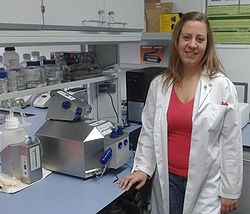Doerrier 2012 Abstract Bioblast
| Doerrier C, Garcia JA, Escames G, Acuna-Castroviejo D (2012) Treatment with melatonin prevents myocardial mitochondrial dysfunction in experimental sepsis in mice. Mitochondr Physiol Network 17.12. |
Link: MiPNet17.12 Bioblast 2012 - Open Access
Doerrier C, Garcia JA, Escames G, Acuna-Castroviejo D (2012)
Event: Bioblast 2012
Sepsis is a systemic inflammatory response syndrome of an organism against an infection. Sepsis is the major cause of hospitalization in the Intensive Care Unit of developed countries, and shows a high mortality and morbidity. Previous studies showed that sepsis induces a significant increase of mitochondrial iNOS isoform (i-mtNOS), with a consequent increase in nitric oxide (NO•) levels. NO• can react with the superoxide anion (O2•-) generating the highly toxic peroxynitrites (ONOO-) that, in turn, irreversibly impair all complex of the respiratory chain (RC). Thus, during sepsis, the activity of the respiratory complexes decreased significantly, favoring the electron leak and, hence, the formation of reactive oxygen species (ROS). Melatonin (aMT) is a potent-free radical scavenger with antioxidant and anti-inflammatory properties. Melatonin counteracts the damage by oxidative stress in sepsis through iNOS/i-mtNOS inhibition, increases the mitochondrial respiratory chain activity, decreasing ROS production, stabilization of mitochondrial membranes, decreasing the lipid peroxidation and stimulating the expression and/or activity of some antioxidants systems. In the present study, we evaluated the involvement of mitochondrial dysfunction in the development of experimental sepsis in mice and the protective role of melatonin. Studies were performed in heart muscle of male C57BL/6 mice (3 months), and sepsis was induced by cecal ligation and puncture (CLP). Mitochondrial respiration was assessed with permeabilized fibres from mouse myocardium by high-resolution respirometry at 37º C. Our results showed a significant decrease in the OXPHOS capacities with different substrates combinations in septic mice. Electron transfer-pathway (ET-pathway) capacity decreased also with the development of the disease. Together, the data suggest a severe mitochondrial dysfunction during sepsis. Melatonin treatment significantly improved the bioenergetic failure, restoring the normal mitochondrial physiology in heart from septic mice.
- Escames G, León J, Macías M, Khaldy H, Acuña-Castroviejo D (2003) Melatonin counteracts lipopolysaccharide induced expression and activity of mitocondrial nitric oxide synthase in rats. FASEB J 17: 932-934.
- Acuña-Castroviejo D, Martin M, Macias M, Escames G, León J, Khaldy H, Reiter RJ (2001) Melatonin, mitochondria, and cellular bioenergetics. J Pineal Res 30: 65-74.
- Escames G, López LC, Ortiz F, López A, García JA, Ros E, Acuña-Castroviejo E (2007) Attenuation of cardiac mitochondrial dysfunction by melatonin in septic mice. FEBS J 274: 2135-2147.
• Keywords: Mitochondria, Melatonin, Oxidative stress, Sepsis, Bioenergetic
• O2k-Network Lab: ES Granada Acuna-Castroviejo D
Labels:
Stress:Oxidative stress;RONS, Mitochondrial disease Organism: Mouse Tissue;cell: Heart Preparation: Permeabilized tissue Enzyme: Marker enzyme Regulation: Redox state Coupling state: LEAK, OXPHOS, ET Pathway: N, S, NS HRR: Oxygraph-2k
Affiliations and author contributions
Instituto de Biotecnología, Centro de Investigación Biomédica, Parque Tecnológico de Ciencias de la Salud, Universidad de Granada, Granada, Spain; Email: cdoerrier@ugr.es
Supported in part by grants # RD06/0013/0008, P07-CTS-03135, and P10-CTS-5784
